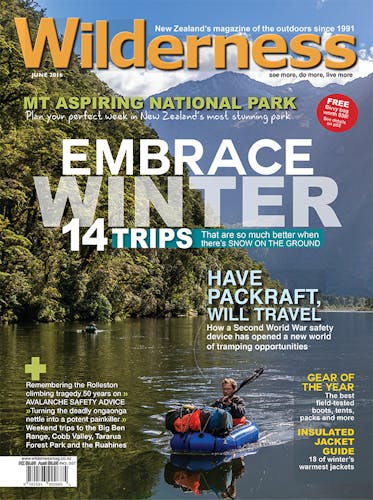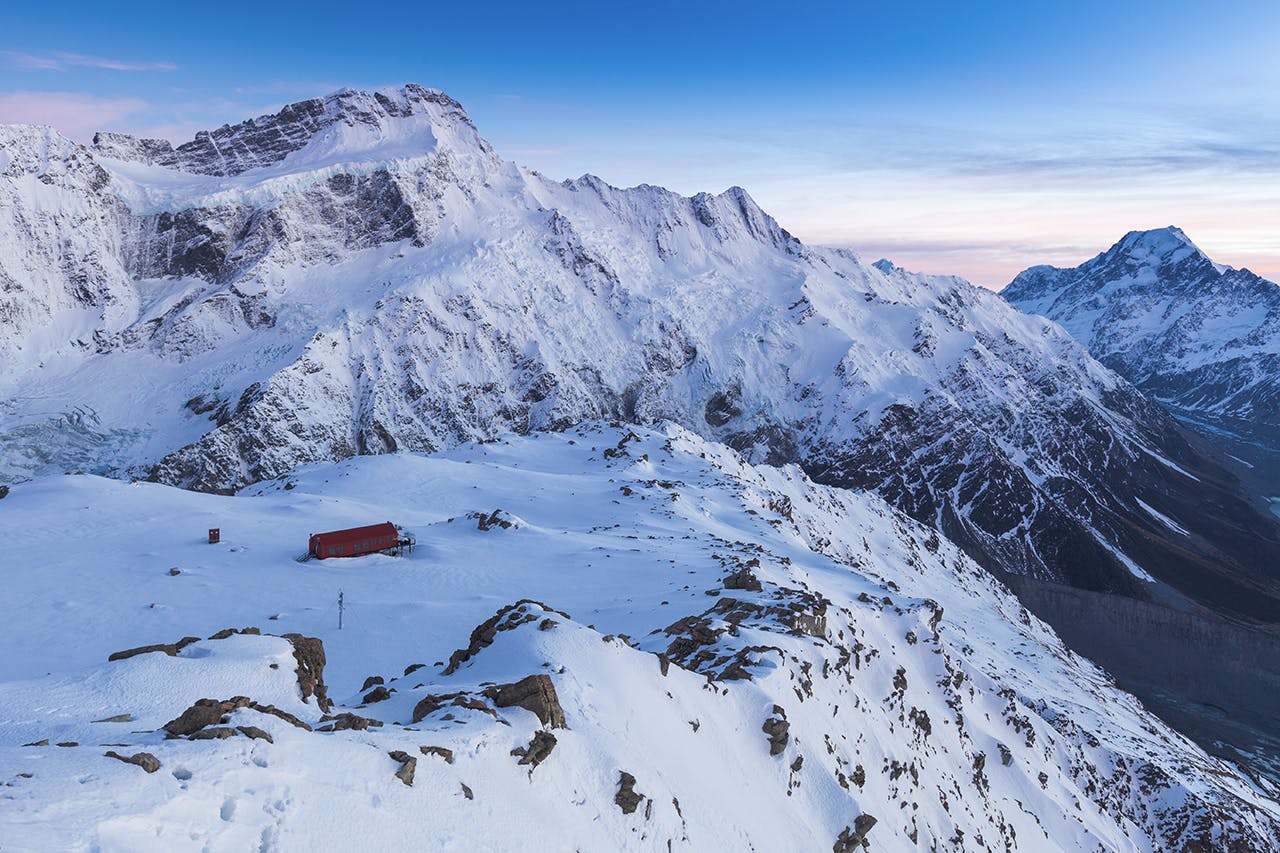1. Mueller Hut, Aoraki/Mt Cook National Park
Mueller Hut’s position on the Sealy Range, opposite the colossal east face of Mt Sefton, is remarkable and is one of New Zealand’s most spectacularly-sited huts, period. Venture to this location during winter and you’re in for a treat; not only is ‘New Zealand’s Highest Backpackers’ likely to be quiet, you’ll be witnessing some of the country’s highest mountains at their pictorial best under the freshness of their winter coat.
It’s a 1000m climb to the hut via Sealy Tarns – a great winter day-walk destination. To the tarns, the path is well formed and climbs steep steps. Beyond, the track is unformed but poled and easy to follow to the Sealy Range. Once on the range, turning north leads to a rocky knoll with good, clear views towards Sefton and Aoraki/Mt Cook. Turn left to reach the hut.
During winter and spring there are avalanche hazards, particularly the final slope onto the crown of the Sealy Range, below Mueller Hut. Ice axe and crampons are required and extra fuel for melting snow.
Access White Horse Hill parking area Grade Moderate Time 4hr
2. Kime Hut, Tararua Forest Park
Kime Hut is unquestionably popular – perhaps too much so – but had to be on this list for reasons of accessibility and its status as one of the most classic hut locations in New Zealand.
Embedded in Wellington tramping folk-lore and steeped in history, this overnight stop on the Southern Crossing is situated in a basin about an hour’s walk from the highest point in the Southern Tararuas, Mt Hector; famous for its huge wooden memorial cross dedicated to Wellington-area tramping club members killed during the Second World War.
The tramp to the hut from Otaki Forks is a very pleasant and steady climb through podocarp and beech forest. Tops travel through tussock and leatherwood follows and if you’re lucky enough to catch the Tararuas on a clear day, the view into the interior and to the Kapiti Coast is fantastic.
While winter snow would rarely allow it now, consider that the mellow basins near Kime Hut were once used for recreational skiing by local tramping clubs.
Access A landslip on Otaki Gorge Rd has made access more difficult. A temporary track from Shields Flat adds about 2hr onto the walk Grade Moderate Time 7-8hr
3. Liverpool Hut, Mt Aspiring National Park
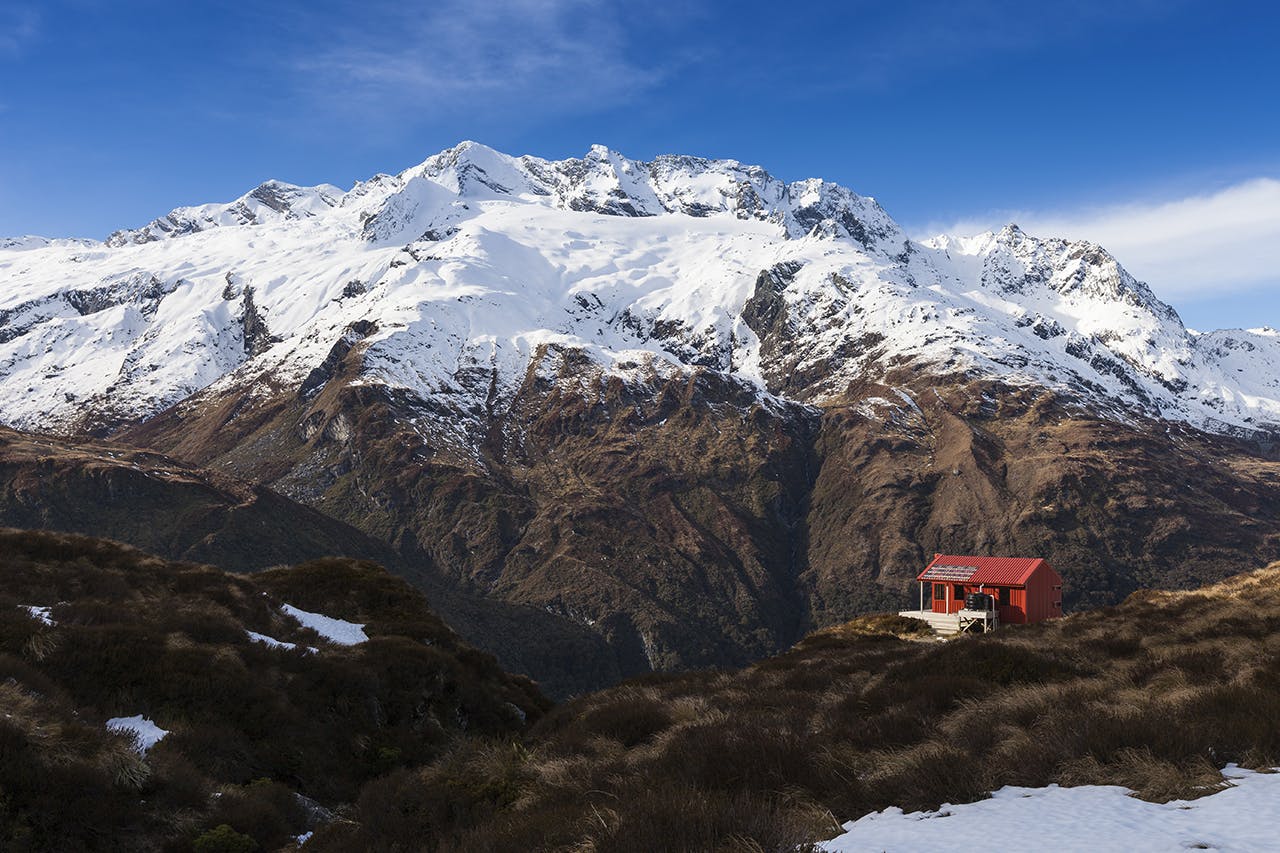
Rob Roy Peak and Liverpool Hut. Photo: Mark Watson
A trip to Liverpool Hut combines a variety of tramping terrain and makes a great location for a two- to three-day tramp.
Walk to Aspiring Hut through open terrain, much of it still grazed, along the expansive and scenic Matukituki Valley. The hut is an NZ Alpine Club classic with river stone walls, ample lounging space and great views. From here, the tramping becomes more intimate as the track enters the beech forest, crossing swingbridges and an open flat. As the valley begins to narrow at Pearl Flat, the Liverpool Hut Track climbs steeply for a bit over 500m to the hut, situated just above the bushline.
The hut is positioned opposite Rob Roy Peak, one of the tallest in Mt Aspiring National Park and this mountain’s massif dominates the far side of the valley. French Ridge and French Ridge Hut are also visible from this location. Built to replace a much smaller and more basic bivouac built by the NZ Alpine Club in 1953, the hut is well-insulated for winter comfort.
Access Wanaka Mt Aspiring Road end Grade Moderate Time 5-6.5hr
4. Buckland Peaks Hut, Paparoa National Park
A great overnight location on a quiet part of the West Coast, Buckland Peaks Hut is situated just inside the bushline and below Buckland Peaks, which form the northern end of the Paparoa Range.
A trudge along a farm road accessway is soon forgotten as the track climbs steeply through pleasant lowland and beech forest, before emerging briefly onto open tops and then descending to the hut.
Epic views of Cape Foulwind, the Buller River mouth and Westport are one of the highlights of this location, but for those with extra energy and the yearning for a summit the extra walk to the craggy Buckland Peaks themselves is well worth it for expansive views, particularly peaks of the Paparoa Range to the south.
Snow conditions will vary significantly here – do some research and equip yourself accordingly – but a trip made in winter guarantees peace and quiet and a cosy evening in the hut.
Access SH6 south of Westport Grade Easy Time 4hr
5. Mt Arthur Hut, Kahurangi National Park
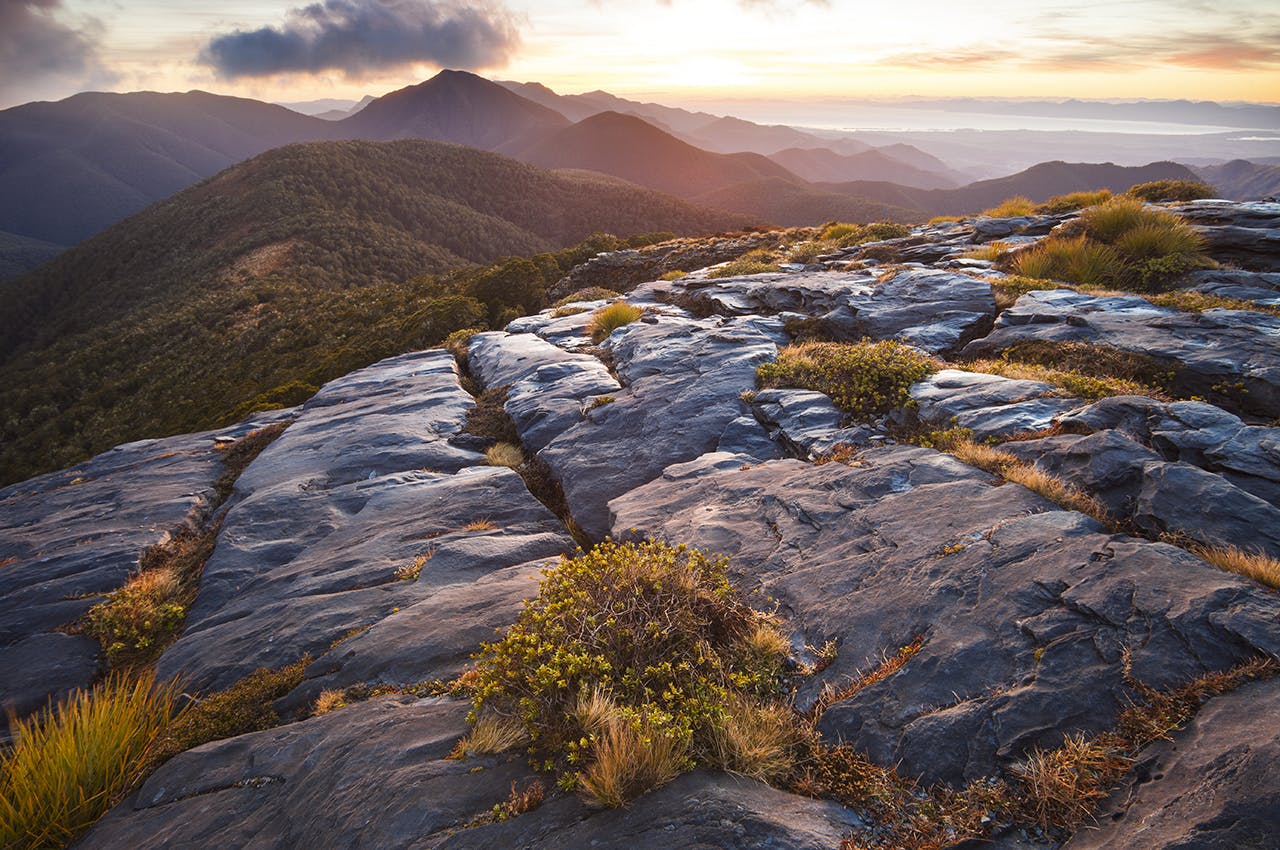
Incredible views to the north from near Mt Arthur Hut. Photo: Mark Watson
A very accessible location, Mt Arthur Hut has long been a tramping destination for many Nelsonians starting out on their tramping careers.
The track follows an easy tramping track through montane beech, dotted in places by distinctive ‘Dr Suess trees’ – better known as dracophyllum. These beautiful plants are prolific in the area and lend the bush a unique quality.
After a gradual climb, this well-sited hut is found on the bush edge with great views to the north and can be reached in snowy conditions without needing special equipment. A limestone knoll a short distance beyond the hut provides better views, including the amazing karst landscape of the Mt Arthur massif above the hut.
Depending on snow cover, ice-axe and crampons may be required beyond the hut; but Mt Arthur itself makes a wonderful winter prize for those with the skill and experience to venture on. The route follows an obvious ground trail and is marked, but is exposed in places.
Access Graham Valley Road car park Grade Easy Time 1-3hr
6. Pouakai Hut, Egmont National Park
The Pouakai Range is a small outlier to the main volcanic cone of Taranaki/Mt Egmont and is serviced by an easily accessed hut and tracks that join the network of tracks around Mt Egmont itself. It can be visited by just a couple of hours tramp from the road and makes a great overnight stop for a quick getaway or as a destination for a longer tramp.
It’s a special location, an oasis of sorts among the surrounding farmland and urban areas, and you travel through rich native bush to reach it. Mountain cabbage tree and montane totara are two of the notable trees you’ll encounter, and the stunted, mossy beech forest can be very special.
Access Mangorei Road end Grade Easy Time 2-3hr
7. Rangipo Hut, Tongariro National Park
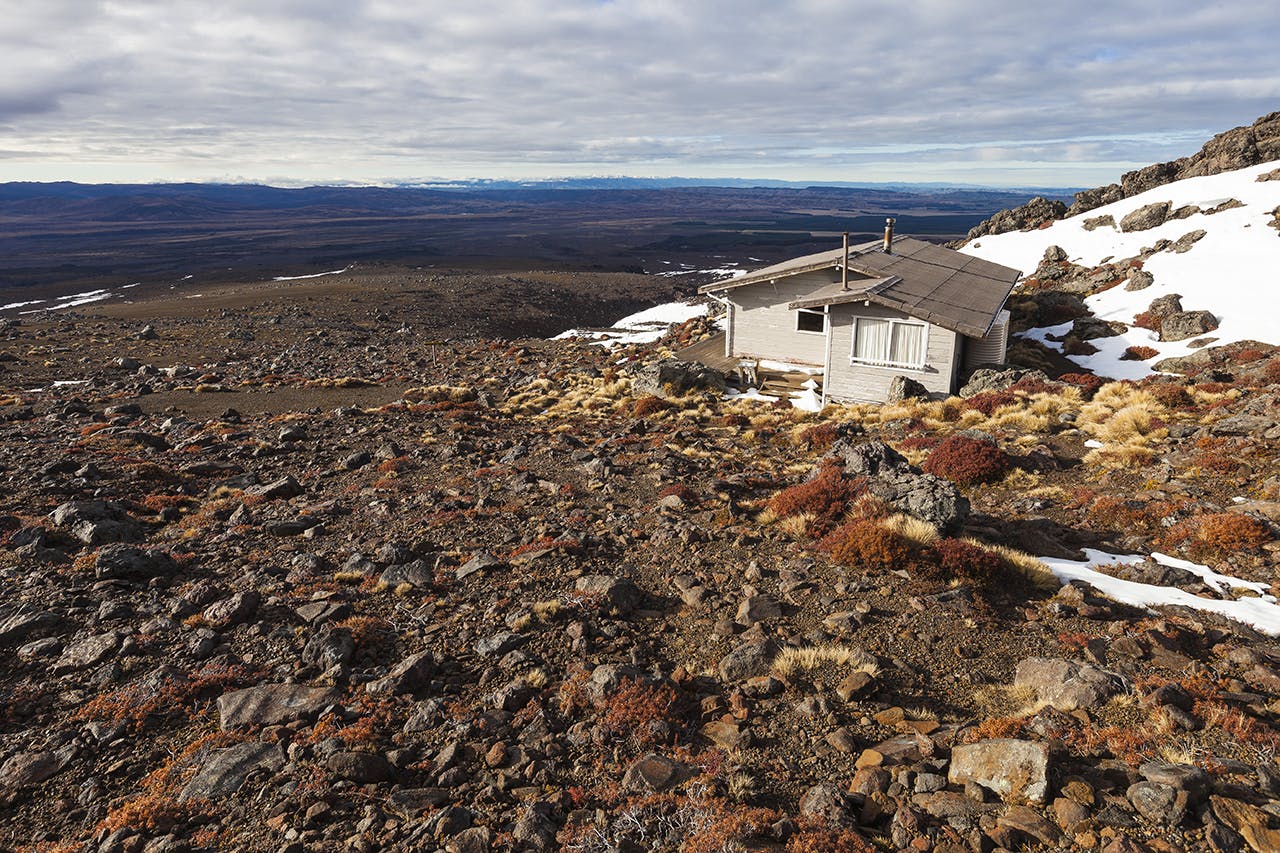
Rangipo Hut overlooks a desert landscape. Photo: Mark Watson
Selected for its special location, Rangipo Hut sits on the flanks of the eastern side of Mt Ruapehu in Te Onetapu/Rangipo Desert. Volcanic eruptions and dry winds have created this unique environment and the walk in is a journey through curious rock-scapes and subtle volcanic colours. Scarce, but hardy plants hold the loose volcanic ground together.
Commonly visited as part of the Round the Mountain Track, the hut is most easily reached from Tukino Ski Field. En route, the Whangaehu River is crossed. This well-known river drains Ruapehu’s Crater Lake, and the scoured walls of its small gorge are testament to the volumes of lahar-forming floodwater that has cascaded down here in times past.
The hut has a pot belly stove and warms well on a winter night. The view from the porch is a treat: the Kaimanawa Mountains form the horizon and below, at night, the lights of traffic on the Desert Road can be seen twinkling. If your visit coincides with military exercises in the area between the hut and the highway you might hear occasional gunfire – another of the things that makes this pocket of New Zealand unique.
Access Graham Valley Road car park Grade Moderate Time 4-5 days





